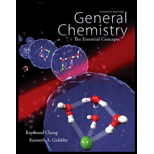
Concept explainers
(a)
Interpretation:
The pressures in valves (b) and (c) has to be calculated.
(a)
Answer to Problem 5.117QP
The partial pressures in valves (b) and (c) is
Explanation of Solution
Bulb (b) contains the same number of particles as (a), but is half the volume. The pressure will be double that of A.
The volume of bulb (c) is the same as bulb (a), but there are
(b)
Interpretation:
The total pressure and partial pressure of each gas after the valves are opened has to be calculated.
(b)
Answer to Problem 5.117QP
The total pressure in the container is the sum of the partial pressures is
The partial pressure is
Explanation of Solution
The valves are opened at constant temperature, the gases expand to fill the entire container. In bulb (a), the pressure before opening the valve is
Given data,
Given data,
Given data,
The total pressure in the container is the sum of the partial pressures
There are 15 particles of gas A and 15 particles of gas B in the container. Therefore, the partial pressure of each gas will be half the total pressure of
Want to see more full solutions like this?
Chapter 5 Solutions
Package: General Chemistry with Connect 2-year Access Card
 ChemistryChemistryISBN:9781305957404Author:Steven S. Zumdahl, Susan A. Zumdahl, Donald J. DeCostePublisher:Cengage Learning
ChemistryChemistryISBN:9781305957404Author:Steven S. Zumdahl, Susan A. Zumdahl, Donald J. DeCostePublisher:Cengage Learning ChemistryChemistryISBN:9781259911156Author:Raymond Chang Dr., Jason Overby ProfessorPublisher:McGraw-Hill Education
ChemistryChemistryISBN:9781259911156Author:Raymond Chang Dr., Jason Overby ProfessorPublisher:McGraw-Hill Education Principles of Instrumental AnalysisChemistryISBN:9781305577213Author:Douglas A. Skoog, F. James Holler, Stanley R. CrouchPublisher:Cengage Learning
Principles of Instrumental AnalysisChemistryISBN:9781305577213Author:Douglas A. Skoog, F. James Holler, Stanley R. CrouchPublisher:Cengage Learning Organic ChemistryChemistryISBN:9780078021558Author:Janice Gorzynski Smith Dr.Publisher:McGraw-Hill Education
Organic ChemistryChemistryISBN:9780078021558Author:Janice Gorzynski Smith Dr.Publisher:McGraw-Hill Education Chemistry: Principles and ReactionsChemistryISBN:9781305079373Author:William L. Masterton, Cecile N. HurleyPublisher:Cengage Learning
Chemistry: Principles and ReactionsChemistryISBN:9781305079373Author:William L. Masterton, Cecile N. HurleyPublisher:Cengage Learning Elementary Principles of Chemical Processes, Bind...ChemistryISBN:9781118431221Author:Richard M. Felder, Ronald W. Rousseau, Lisa G. BullardPublisher:WILEY
Elementary Principles of Chemical Processes, Bind...ChemistryISBN:9781118431221Author:Richard M. Felder, Ronald W. Rousseau, Lisa G. BullardPublisher:WILEY





